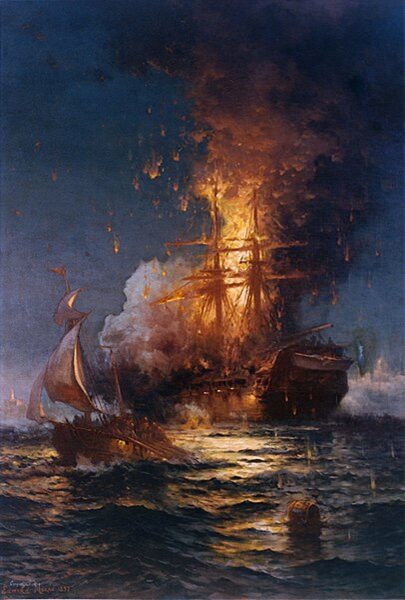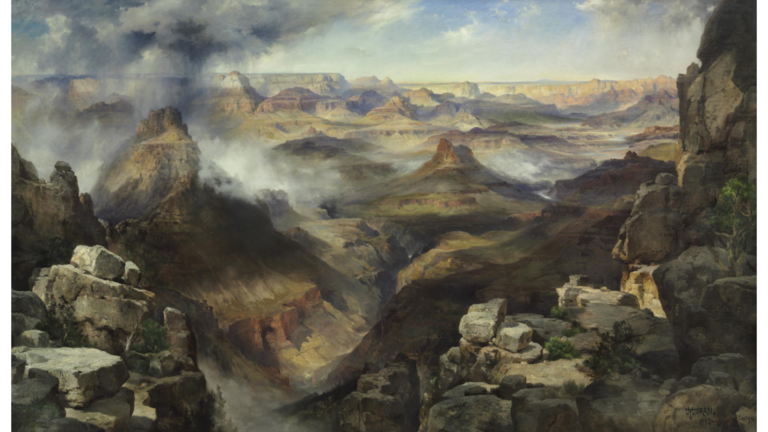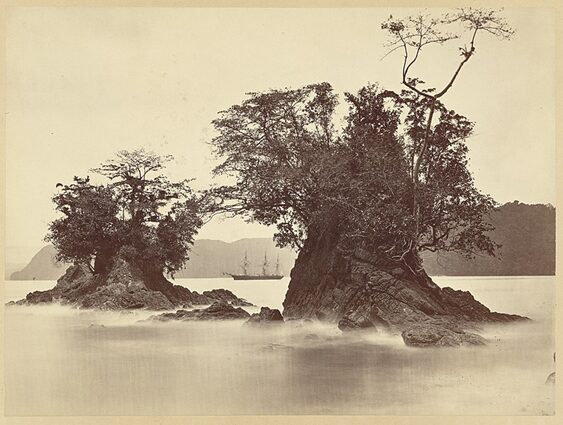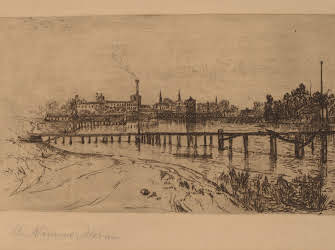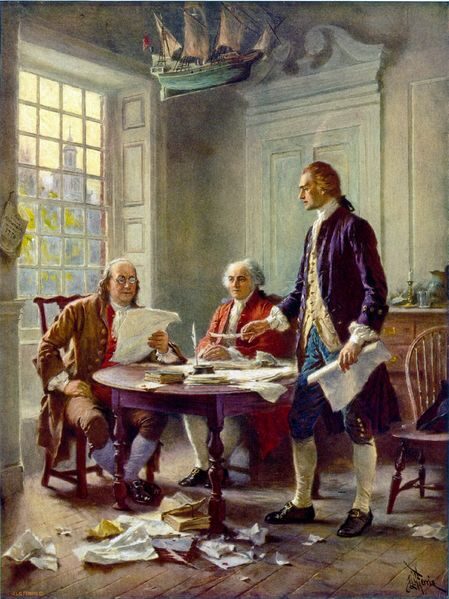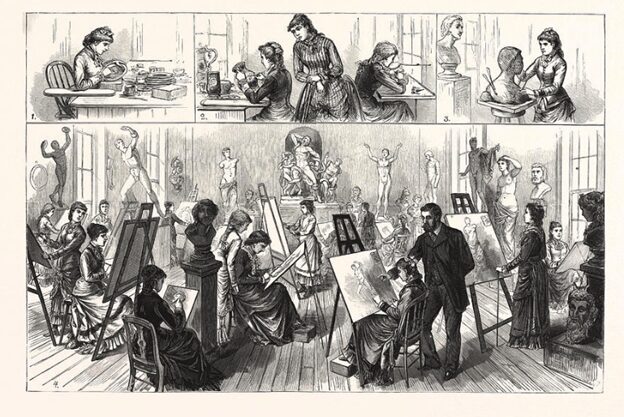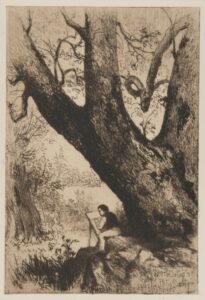Moran Family of Artists
Essay
The Morans, a multi-generational family of American artists, lived and worked in Philadelphia during the second half of the nineteenth century. Some contributed to the development of Philadelphia’s art world while others learned their trade locally then left to pursue professions elsewhere. Landscapes and seascapes were prominent among their subjects, although some of the Morans painted figural and historical subjects. In addition to working in oils, they advanced the arts of etching, photography, and watercolor through exhibitions and their work as educators.
The family patriarch, Irish-born Thomas Moran Sr. (1802-62), a handloom weaver, moved to the United States in 1842. His wife, Mary Higson Moran (1807-83), joined him with their seven children in 1844; three more children were born after their move. The family settled in Kensington (then outside the city limits of Philadelphia), where the elder Morans joined a community of immigrant textile workers, many of them Irish.

The port city of Philadelphia was already a center for marine painting when Edward Moran (1829-1901), the oldest of the brothers, moved there from Kensington in 1855. Edward worked initially in the textile industry like his parents. One of his early supervisors, impressed with his drawing ability, reinforced his determination to become an artist. In the early 1850s he met the Philadelphia marine painter James Hamilton (1819-1878), who became his teacher and friend. He also learned from Paul Weber (1823-1916), a German-born landscapist who worked in Philadelphia during the 1850s and later. Edward exhibited for the first time at the Pennsylvania Academy of the Fine Arts (PAFA) in 1854. Like his mentor Hamilton, he specialized in romanticized paintings of ships at sea, often with dramatic weather and lighting effects. Edward Moran taught painting to several younger artists including his brothers Thomas (1837-1926) and Peter (1841-1914). He was voted an Academician of PAFA (a full member) in 1860 and in the spring of 1871 moved to New York City. By the end of the century, he was recognized as one of America’s leading marine painters.

Eight years younger than Edward, Thomas Moran became the most famous of the brothers, best known for American landscape, a subject made popular earlier in the century by the Hudson River School painters. Thomas apprenticed in 1853 as a wood engraver at the Philadelphia engraving firm of Scattergood and Telfer. He also studied painting with his older brother Edward and with James Hamilton, who inspired both brothers to emulate the colorful sunsets and painterly handling of the English artist J.M.W. Turner (1775-1851). In 1856 Thomas moved into Philadelphia to live with Edward. He exhibited watercolors at PAFA that year and was voted an Academician in 1861. Thomas Moran left for Newark, New Jersey, in the winter of 1871-72 and moved into New York City a decade later. Much of his later work in oils and watercolors featured landscapes of the American West. When Moran died he was eulogized as the “Dean of American Landscape Painters.”
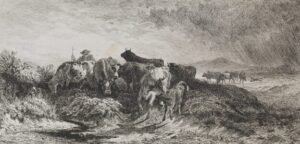
Peter Moran, the youngest of the artist brothers, began his career as an apprentice with the Philadelphia printing firm of Herline & Hensel and worked briefly as a lithographer. He also trained as a chair painter’s apprentice in 1860 while studying easel painting with his older brothers Edward and Thomas. Peter Moran traveled to England to see the animal paintings of Edwin Landseer (1802-73). He specialized in bucolic eastern landscapes with animals and images of life in New Mexico, which he first visited in 1880 (not 1864 as previously thought) and that he captured in oil, watercolor, and etching.
Of the Moran brothers, Peter was the most active in Philadelphia’s growing art world. He joined the Philadelphia Society of Artists by 1880 and the Art Union of Philadelphia in 1887. Like his brothers Edward and Thomas he was a member of the Philadelphia Sketch Club, and he helped found the Art Club of Philadelphia in 1887. As a founding member of the Philadelphia Society of Etchers in 1880 and president of the group until 1903, Peter was instrumental in Philadelphia’s etching revival of the 1880s. The Society’s first exhibition, held in the winter of 1882-83, included prints by several of the Morans. Peter exhibited thirty-seven etchings at the Centennial Exhibition in Philadelphia, where his painting The Return of the Herd received a medal. (It was placed in the spot formerly occupied by Thomas Eakins’ The Gross Clinic after the latter was moved to the medical pavilion.)
The Morans’ sister Elizabeth (1839-1913) expanded the family’s artistic dynasty when she married the painter Stephen James Ferris (1835-1915) in 1862. They may have met in 1860, when Ferris and Elizabeth’s brother Thomas learned etching from the engraver and publisher John Sartain (1808-97). Ferris was born in Plattsburgh, New York, and arrived in Philadelphia at the age of twenty-one to study at PAFA. He remained for the rest of his career, exhibiting his work and teaching at the Philadelphia School of Design for Women. With Peter Moran and Joseph Pennell (1857-1926), Ferris was a founder of the Philadelphia Society of Etchers. He also helped found the Philadelphia Sketch Club and gave etching demonstrations for the members. Ferris’s prints depict portraits and historical subjects.
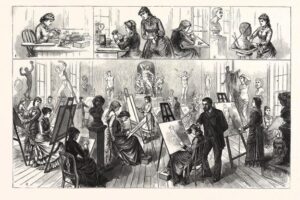
Several members of the Moran family taught at the Philadelphia School of Design for Women (later renamed Moore College of Art and Design). Thomas Moran and his brother-in-law Stephen Ferris spoke in a lecture series in 1865, and Thomas lectured there in other years. Ferris continued his affiliation with the school for nearly twenty-five years, teaching figure drawing and painting from live models and plaster casts of statues. Peter Moran’s tenure was longest. He began as a lecturer in 1866 and was elected professor in 1872, teaching etching as well as landscape painting in oil and watercolor until 1896.
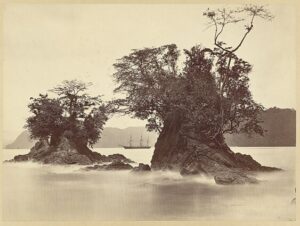
John Moran (1831-1902), second oldest of the brothers, achieved notable contributions in photography. After beginning his career in lithography, he switched to the camera by 1859 and helped establish Philadelphia as an early center for photography. In 1864, several of his original landscape photographs were tipped-in as illustrations for the important journal Philadelphia Photographer. Moran argued for the artistic importance of photography in a lecture before the Philadelphia Photographic Society that was published in Philadelphia Photographer in April 1872.
John Moran also photographed Philadelphia architecture and street scenes. One series featured Mower General Hospital in Chestnut Hill, which was built in 1862 for the care of Civil War wounded. His work took him on the Darien Expedition of 1871-73, which surveyed the Isthmus of Panama in search of a canal route, and on an expedition to South Africa and Tasmania in 1874 to document the Transit of Venus (the passing of Venus in front of the sun). According to his obituary in the New York Times, John Moran was a leading photographer for the United States Coast Survey.
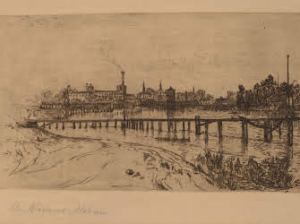
Scottish-born Mary Nimmo Moran (1842-1899), Thomas’s wife, contributed to printmaking and the etching revival of the 1880s. Noteworthy for the quality of her landscape etchings, in terms of image and technique, she was elected a member of the Society of Painters and Etchers of New York and was the only woman among the sixty-five original fellows of London’s Royal Society of Painters and Etchers. In the late 1880s, she and her sister-in-law Emily Kelley Moran (1841-1903) exhibited prints with the New York Union League Club and the Women Etchers of America in Boston. Mary Moran also painted landscapes in oils and watercolors.

Irish-born Emily Kelley Moran, Peter’s wife, exhibited prints for the first time at PAFA’s spring 1877 exhibition, although her work was mistakenly attributed to her husband. She exhibited etchings at the Museum of Fine Arts, Boston in 1881 and in the first show of the Philadelphia Society of Etchers in 1882-83. Emily was described in 1889 as having a “considerable reputation as an artist, both as an etcher and painter.” She worked in both watercolor and oil, creating dark-toned landscapes in the Barbizon mode.
Stephen Ferris’ son, Jean Léon Gérome Ferris (1863-1930), was named for a French artist his father admired. The younger Ferris was nationally known for his series of seventy-eight canvases titled The Pageant of a Nation, the largest series of American history paintings ever made by a single artist. Widely distributed in museum collections across the country, several canvases in the series depicted historical events in Philadelphia.
The artistic dynasty founded by Thomas Moran, Sr. became one of the most culturally influential families of nineteenth-century America. Through their work across a wide range of media, their often foundational participation in arts organizations, and their work as educators, the Morans advanced the development of the visual arts both in Philadelphia and nationwide. Over a century since their creation, the Morans’ paintings, prints, and photographs continue to be celebrated, preserved, and displayed in the Philadelphia Museum of Art, the Pennsylvania Academy of the Fine Arts, and other museums and collections across the country.
Kate Nearpass Ogden, Professor of Art History at Stockton University in Galloway, New Jersey, received her Ph.D. from Columbia University, New York. Her publications have focused on nineteenth-century American painting and photography.
Copyright 2024, Rutgers University.
